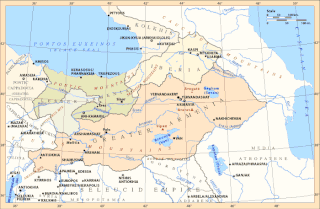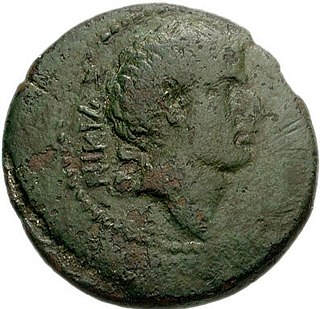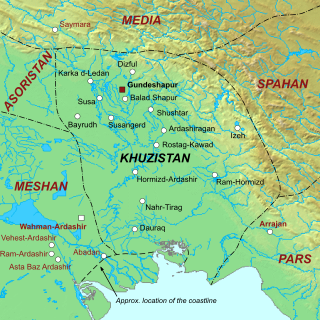
Romulus Augustus, nicknamed Augustulus, was Roman emperor of the West from 31 October 475 until 4 September 476. Romulus was placed on the imperial throne by his father, the magister militum Orestes, and, at that time still a minor, was little more than a figurehead for his father. After Romulus ruled for just ten months, the barbarian general Odoacer defeated and killed Orestes and deposed Romulus. As Odoacer did not proclaim any successor, Romulus is typically regarded as the last Western Roman emperor, his deposition marking the end of the Western Roman Empire as a political entity, despite the fact that Julius Nepos would continue to be recognised as the western emperor by the east. The deposition of Romulus Augustulus is also sometimes used by historians to mark the transition from antiquity to the medieval period.

Damnatio memoriae is a modern Latin phrase meaning "condemnation of memory", indicating that a person is to be excluded from official accounts. Depending on the extent, it can be a case of historical negationism. There are and have been many routes to damnatio memoriae, including the destruction of depictions, the removal of names from inscriptions and documents, and even large-scale rewritings of history. The term can be applied to other instances of official scrubbing. The practice has been seen as early as the Egyptian New Kingdom period, where the Pharaohs Hatshepsut and Akhenaten were subject to it.

The pontifex maximus was the chief high priest of the College of Pontiffs in ancient Rome. This was the most important position in the ancient Roman religion, open only to patricians until 254 BC, when a plebeian first held this position. Although in fact the most powerful office in the Roman priesthood, the pontifex maximus was officially ranked fifth in the ranking of the highest Roman priests, behind the rex sacrorum and the flamines maiores.

Kos or Cos is a Greek island, part of the Dodecanese island chain in the southeastern Aegean Sea. Kos is the third largest island of the Dodecanese by area, after Rhodes and Karpathos; it has a population of 36,986, making it the second most populous of the Dodecanese, after Rhodes. The island measures 42.1 by 11.5 kilometres. Administratively, Kos constitutes a municipality within the Kos regional unit, which is part of the South Aegean region. The principal town of the island and seat of the municipality is Kos Town.

The Nazareth Inscription or Nazareth decree is a marble tablet inscribed in Greek with an edict from an unnamed Caesar ordering capital punishment for anyone caught disturbing graves or tombs. It is dated on the basis of epigraphy to the first half of the 1st century AD. Its provenance is unknown, but a French collector acquired the stone from Nazareth. It is now in the collections of the Louvre.
In Roman literature of the early 1st century CE, the Moesi appear as a Paleo-Balkan people who lived in the region around the River Timok to the south of the Danube. The Moesi do not appear in ancient sources before Augustus's death in 14 CE and are mentioned only by three authors: Ovid, Strabo and Livy. Recent research suggests that a Paleo-Balkan people known as the Moesi never actually existed but the name was transplanted from Asia Minor Mysians to the Balkans by the Romans as an alternative name for the people who lived in the later province of Moesia Superior as Dardani communities. This decision in Roman literature is linked to the appropriation of the name Dardani in official Roman ideological discourse as Trojan ancestors of the Romans and the creation of a fictive name for the actual Dardani who were seen as barbarians and antagonists of Rome in antiquity.

Pre-Islamic Arabia refers to the Arabian Peninsula before the emergence of Islam in 610 CE.

The Punic religion, Carthaginian religion, or Western Phoenician religion in the western Mediterranean was a direct continuation of the Phoenician variety of the polytheistic ancient Canaanite religion. However, significant local differences developed over the centuries following the foundation of Carthage and other Punic communities elsewhere in North Africa, southern Spain, Sardinia, western Sicily, and Malta from the ninth century BC onward. After the conquest of these regions by the Roman Republic in the third and second centuries BC, Punic religious practices continued, surviving until the fourth century AD in some cases. As with most cultures of the ancient Mediterranean, Punic religion suffused their society and there was no stark distinction between religious and secular spheres. Sources on Punic religion are poor. There are no surviving literary sources and Punic religion is primarily reconstructed from inscriptions and archaeological evidence. An important sacred space in Punic religion appears to have been the large open air sanctuaries known as tophets in modern scholarship, in which urns containing the cremated bones of infants and animals were buried. There is a long-running scholarly debate about whether child sacrifice occurred at these locations, as suggested by Greco-Roman and biblical sources.

The Satrapy of Armenia, a region controlled by the Orontid dynasty, was one of the satrapies of the Achaemenid Empire in the 6th century BC that later became an independent kingdom. Its capitals were Tushpa and later Erebuni.

Ancient Carthage was an ancient Semitic civilization centered in North Africa. Initially a settlement in present-day Tunisia, it later became a city-state and then an empire. Founded by the Phoenicians in the ninth century BC, Carthage reached its height in the fourth century BC as one of the largest metropolises in the world. It was the centre of the Carthaginian Empire, a major power led by the Punic people who dominated the ancient western and central Mediterranean Sea. Following the Punic Wars, Carthage was destroyed by the Romans in 146 BC, who later rebuilt the city lavishly.

Edom was an ancient kingdom in Transjordan, located between Moab to the northeast, the Arabah to the west, and the Arabian Desert to the south and east. Most of its former territory is now divided between present-day southern Israel and Jordan. Edom appears in written sources relating to the late Bronze Age and to the Iron Age in the Levant.

The Labeatae, Labeatai or Labeates were an Illyrian people that lived on the Adriatic coast of southern Illyria, between modern Albania and Montenegro, around Lake Scodra.

The Temple of Artemis or Artemision, also known as the Temple of Diana, was a Greek temple dedicated to an ancient, local form of the goddess Artemis. It was located in Ephesus. By 401 AD it had been ruined or destroyed. Only foundations and fragments of the last temple remain at the site.
The Enchelei were an ancient people that lived around the River Drin and the region of Lake Shkodra and Lake Ohrid, in modern-day Albania, Montenegro, and North Macedonia. They are one of the oldest known peoples of the eastern shore of the Adriatic Sea. In ancient sources they sometimes appear as an ethnic group distinct from the Illyrians, but they are mostly mentioned as one of the Illyrian tribes. They held a central position in the earlier phase of Illyrian history. In ancient Greek literature they are linked with the end of the mythical narrative of Cadmus and Harmonia, a tradition deeply rooted among the Illyrian peoples.

Publius Sulpicius Quirinius, also translated as Cyrenius, was a Roman aristocrat. After the banishment of the ethnarch Herod Archelaus from the tetrarchy of Judea in AD 6, Quirinius was appointed legate governor of Syria, to which the province of Judaea had been added for the purpose of a census.
The banker of ancient times was employed within financial activities, during the ancient Mesopotamian, ancient Greek and ancient Roman periods.

Nicias, also known as Curtias Nicias, was a ruler of the island of Kos under Roman rule, during the Second Triumvirate and the early reign of Augustus. He is known from coinage, inscriptions, and anecdotes in ancient literary sources. Ancient sources call him a tyrant. The desecration of his tomb may have prompted the Nazareth Inscription.

Khuzistan or Huzistan was a Sasanian province in Late Antiquity, which almost corresponded to the present-day province of Khuzestan. Its capital was Gundeshapur. During the late Sasanian era, the province was included in the southern quadrant (kust) of Nemroz.














